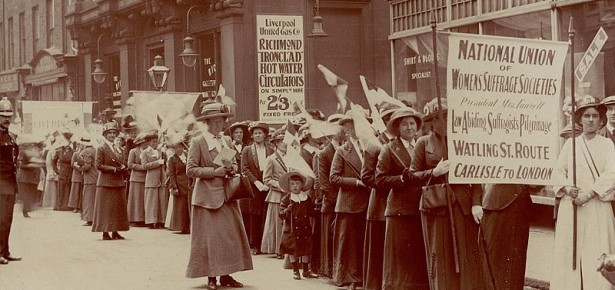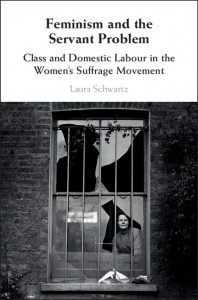
On Saturday 18th June 1910, the Women’s Social and Political Union staged one of its largest and most spectacular demonstrations. The Great Procession through the streets of central London was carefully choreographed and divided into numerous different ‘contingents’ – each representing a particular class or type of suffrage supporter. There was a special contingent for Irish suffragettes, one for ‘foreign supporters’, and one for women who had attended university. Many of the contingents were organised according to profession, demonstrating the vast array of work done by disenfranchised women. There were teachers, musicians, civil servants and stenographers, gymnastics teachers, pharmacists, sanitary inspectors and health visitors.
Although the achievements of professional women were emphasised and celebrated, the Great Procession also featured women working in more lowly forms of employment. The Votes for Women newspaper recorded that ‘There were also sweated workers in poor clothes and hats that knew no fashion. There were boot-machiners, box-makers, and shirt-makers, who fight daily with starvation.’ Efforts to mobilise for the Great Procession included holding meetings for laundry workers in North London, and the canvassing of ‘factory and laundry districts’ in South London. And yet… domestic servants, the most common and most numerous type of woman worker, were starkly absent from descriptions of the Great Procession.
The myth of women’s suffrage as a wholly ‘middle-class’ phenomenon has now been definitively challenged by number of historians demonstrating the important role played by working-class women in both its militant and constitutionalist wings. Although it was dominated by more educated and affluent women, with the property qualification a continual point of disagreement, the suffrage movement was also aware of class inequality and keen to reach out to working-class women. Domestic servants however, seldom featured in suffrage propaganda and public spectacle, which tended to focus on factory and sweated workers.
The strange invisibility of domestic servants requires further interrogation, given that they made up the vast majority of the female working class, constituting about one third of all women in waged work. Moreover, my research has revealed that servants were active in the grassroots of the movement, making an important contribution to the campaign for the vote. The purpose of my book Feminism and the Servant Problem is twofold: to recover the history of this other kind of working-class woman’s political activism; while also asking why it often proved difficult to incorporate them into suffrage representations of modern and emancipated womanhood.
Charlotte Griffiths was 50 years old when, on the evening of the 11th February 1908, she joined hundreds of other suffragettes in a raid on the Houses of Parliament. Earlier in the day she had been participating in the Women’s Parliament, which had been organised by the WSPU to discuss the injustice of women’s continued disenfranchisement and the government’s repressive action towards militant suffrage campaigners. Initially, St Stephen’s Hall (part of the Houses of Parliament) was the target of a surprise attack by 21 suffragettes who arrived disguised inside a furniture removal van. Charlotte Griffiths joined the second wave of demonstrators attempting to enter the House in the evening, braving not only a ‘solid phalanx of police’, but also a ‘mob of boys’ who assaulted some of her party with ‘stones and sticks’. Griffiths was one of the 50 arrested and tried at Bow Street Magistrates Court where, refusing to find two sureties of £20, she was served a six week prison sentence. She spent only a week in Holloway Prison, however, accepting an offer of sureties to enable her to return home to nurse her ailing mother. These were paid for by John Albert Bright (Liberal MP for Oldham), and Gordon Harvey (Liberal MP for Rochdale).
It was in her capacity as a domestic servant rather than as suffragette that Charlotte Griffiths drew the attention of Members of Parliament, for since at least 1901 she had been employed as a as a ‘nurse domestic’ in the house of John Albert Bright. Bright, son of the famous radical MP John Bright, was, in his own words, ‘rather weak-kneed’ about the question of women’s parliamentary franchise. Although he supported women’s election to town councils and other public bodies, John Albert Bright claimed at the time that he remained unconvinced that the majority of the female population wanted the parliamentary vote. He nevertheless travelled to London to aid Charlotte Griffiths’ release, and, shocked to find her clothed in ‘hideous prison dress’, normally reserved for criminals rather than prisoners of conscience, he moved a protest about the treatment of suffragette prisoners in the House of Commons.
Soon after the suffragettes’ raid on St Stephen’s, the General Committee of the National Liberal Federation debated the question of votes for women, during which Maurice Levy MP denounced a ‘band of women paid organisers … Bringing young girls from their [domestic] employment, placing them on the streets of London amid horrible temptation’. He referred directly to Charlotte Griffiths’ arrest, claiming that John Albert Bright’s wife, Edith, ‘afraid to go out into the streets herself, allowed and induced’ her servant to ‘go and take part in the rowdyism’. Charlotte Griffiths, however, refused to be portrayed as her mistress’ political puppet. The following week she wrote to the Manchester Guardian (the newspaper that had printed Levy’s slander) insisting that ‘I went entirely of my own free will, without any pressure or persuasion, but because I believed the cause was just and right, and that every woman who was able to do so should give her help.’
Rather than simply enacting the political enthusiasms of her employers, it is possible that, to the contrary, Charlotte Griffiths might have helped spur this wing of the Bright family towards more active support for women’s suffrage. Certainly, it was her arrest that prompted John Albert to make his protest in the House of Commons, and also to address female enfranchisement in a speech the following week on the occasion of the election of a woman to Rochdale Town Council. His wife, Edith Bright, became president of the Rochdale branch of the North of England Society for Women’s Suffrage, and their daughter Hester Bright later became its secretary – but this branch was not founded until September 1908, a number of months after Charlotte Griffiths had served a week in Holloway prison.
Charlotte Griffiths was fortunate to be employed by a relatively sympathetic family such as the Brights. Many servants were not so lucky. 16 hour working days and close surveillance by employers made it difficult for domestic workers to attend suffrage meetings. One anonymous ‘Domestic’ wrote to the Woman Worker newspaper in 1908 of how:
‘The WSPU is having a big demonstration here today. I am a member but I cannot get to any meetings. While I sit here my spirit is with the women, wishing them success. My wings are beating hard against the bars of my cage to be free and to be able to help them.’
In an industry in which one’s employment was entirely dependent upon being able to present a good ‘character’ or reference, participation in suffrage agitation, especially militancy, carried an extremely high risk. This ‘Domestic’ had, in the past, been arrested for her activism, describing how, ‘I had a hard fight to get a situation after my imprisonment. I am afraid that if my present mistress were to know that I was an ex-convict she would not want me anymore.’
Despite significant obstacles, a number of servants did interest themselves in the movement, and found the suffrage and feminist press particularly a conducive way of staying up to date with its activities and offering their solidarity. Newspapers such as Votes for Women and the Common Cause would have been relatively accessible to servants since they were sold on the streets or deliberately left lying about in cafes and railway station waiting rooms.[1] Short or serialised articles offered an ideal format for servants who might only have five or ten minutes to spare between the incessant tasks that constituted their long working day.
The correspondence pages proved to be particularly important, because letters could be published anonymously. Correspondence from servants frequently provoked responses from other others in their industry, providing a rare opportunity to collectivise the grievances of an otherwise fragmented and isolated workforce. Servants may well have made up a large proportion of the foot soldiers of the suffrage movement. Between 1906 and 1907 Clementina Black collected 26,261 signatures on a ‘Declaration’ from women stating their wish to receive the franchise on the same terms as men. The professions of 25,000 signatories were analysed, and 2,769 of them described their job as ‘Domestic’. This was the second largest occupational group after ‘Educational’, and more than ten times the number of factory workers’ signatures.
Why then, were you far more likely to see factory and sweated workers in the suffrage movement’s propaganda, than you were servants? My book, which also looks at domestic servants’ trade unions, suggests that that one of the reasons for the relative absence of domestics from the public face of suffrage is that servants, unlike women factory workers, represented not just the possibility of class difference between women but also class conflict – that between mistress and maid in middle-class suffragists very own homes. It also examines how the suffrage movement was resistant to incorporating domestic labour into its vision of productive and ennobling work for women.
Maurice Levy MP found it impossible to believe that Charlotte Griffiths could have been acting on her own behalf. The idea of the servant as merely an extension of their employer – not just in terms of the labour they undertook but also their political allegiances – remained influential into the early twentieth century. Carrying out the wishes of one’s employer without drawing attention to oneself was seen as one of the foremost skills of the successful servant. Trade unionists often dismissed the possibility of organising domestic servants alongside other workers, on the basis that they were passive mouthpieces for their employers and unaware of their own class interests. The suffrage movement was also influenced by such perceptions, despite the best efforts of women such as Charlotte Griffiths. A movement that placed such importance on women having their own political voice; bodily autonomy; economic independence; and individual moral integrity, struggled with the idea of servants as proxy labourers, acting not for themselves but on behalf of another. As a result, when the suffrage movement sought to rally women workers to the Cause, and demonstrate how gaining the vote would improve their lives as well as those of wealthy women, it rarely directed this appeal to domestic servants who remained the ‘wrong’ kind of working-class women. It was not, therefore, wholly a coincidence that, when the franchise was extended in 1918, it was domestic servants who were most likely to be affected by the property qualification which continued to exclude at least 2 million women over the new voting age of thirty.
[1] It was also relatively common for servants to have access to their employers’ newspapers, see Margaret Beetham, ‘Domestic Servants as Poachers of Print: Reading Authority and Resistance in Late Victorian Britain’, in Lucy Delap, Ben Griffin, and Abigail Wills (eds.), The Politics of Domestic Authority in Britain since 1800 (Basingstoke: Palgrave, 2009), 185-203.
A couple of mistresses even complained to the Common Cause that the paper’s content was either too sexually explicit or too informative about workers’ rights to leave it lying within reach of their domestics, Common Cause 26 June 1911, p.682, 7 Dec 1911, pp.621-622.
 Laura Schwartz’s latest book, Feminism and the Servant Problem: Class and Domestic Labour in the Women’s Suffrage Movement, is available now.
Laura Schwartz’s latest book, Feminism and the Servant Problem: Class and Domestic Labour in the Women’s Suffrage Movement, is available now.
Latest Comments
Have your say!